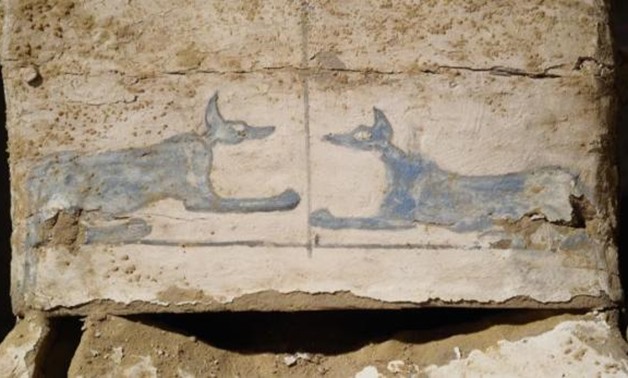
Painting of the god Anubis - ET
CAIRO - 13 October 2019: British website, The Sun, shed light on a burial cemetery discovered in June south of Saqqara. Described by the website as mysterious, the cemetery is allegedly more than 2,000 years old.
A team of Polish archaeologists announced on June 27 in an article published on the website of the Ministry of Science and Higher Education in Poland the stunning discovery of hundreds of mummies in the area of the archaeological Saqqara cemetery.
Notable symbols were also discovered on the tombs. Two drawings of the god Anubis (embalming and after life god) appeared facing one another. According to the Polish researcher who discovered them, the inscriptions are likely to be written by an illiterate worker, The Sun reported. He confirmed that 36 mummies were found in Saqqara, the city of the dead.
Far from the ancient Egyptians' intricate burials we are familiar with, the newly discovered mummies, each aged 2,000 to 2,600 years old, were in an unfortunate state. The mummies were protected only by a thin layer, which indicates that they belonged to the working or middle-class families and not the elite.
"Most of the mummies we discovered were very modest, only exposed to basic mummification treatments, and were placed directly in the pits prepared for them," said Polish Egyptologist Kamel Korazikowicz.

The discovered mummies - ET
"There are no inscriptions or personal objects that might hint at the names or professions of these people; however, analyses of the skeletons' remains indicate that they did hard labor," Korazikowicz continued.
Archaeologists have been working for decades in Saqqara, which served as a cemetery for the entire ancient city of Memphis.
In the cemetery, portraits of a jackal appeared to represent Anubis, the ancient Egyptian god of death. “"It seems that the craftsman who drew it was illiterate and perhaps tried to recreate something he had previously seen. Some of the painted figures are not hieroglyphic signs and the text is not coherent,” stated the Polish Egyptologist.
Despite being far from the tombs of the elite kings and statesmen, the discovery shows that ordinary Egyptians have received similar funerals as their wealthier counterparts, perhaps attempting to emulate the funerary practices of the rich, even if they do not completely understand them.
Saqqara archaeological area is one of the most prominent archaeological areas in Egypt and one of the richest places in Egyptian monuments. It includes Saqqara Amphitheater, the oldest stone structure known to man, as well as the first royal tomb in history, along with many royal tombs dating back to the first Pharaonic dynasties.

Comments
Leave a Comment